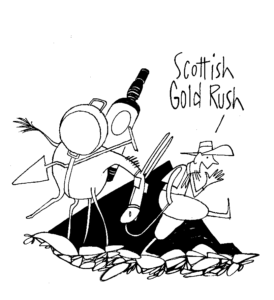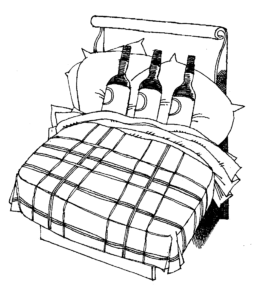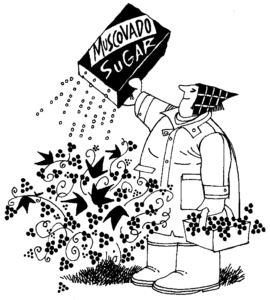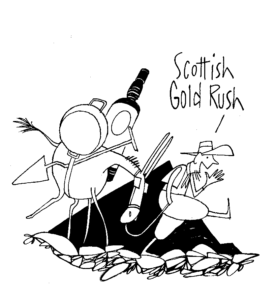The following article was written by American playwright, film director, screenwriter and author, David Mamet. It was written in 1995 for Penthouse Magazine and then faithfully reproduced for attendees to the Vaults 1682 Experience in 2019, complete with spelling errors and all. Here it is in all its glory for you to read again:
—
SCOTCH MALT WHISKY SOCIETY
By David Mamet
I’d had my heart broken and was looking for help. I called a fellow I knew and asked if I could come by. He said yes, and we talked all night, and drank two and a half fifths of Bell’s scotch while doing it. The sun rose and I felt comforted and wise for about a block of the walk home, and then I didn’t taste scotch for twenty years. Fade out, fade in.
Again, it occurs to me, I was being comforted for some enormity my endocrine system had involved me in, sitting in a bar in Cambridge, Mass.
My friend said to the bartender, “Givem’ a shot of your best whisky.”
The bartender reached down a bottle from the top shelf.
“That’s the ticket,” my friend said, “what is it?”
The bartender said some foreign name.
“Fine,” my friend said, “how much?” Sixty-four dollars, he was told.
“Expensive bottle,” he said.
“No,” he was corrected, “by the shot.”
“Put it back,” my friend said, “He’s not that unhappy. Givem’ something in the ten-buck range;” and the bartender poured me a shot of an ambrosia which I only afterward discovered to be scotch.
I drank it. “Well, hell,” I said, “this puts any cognac in the shake.” The bartender nodded.
I remember riding in the car with my dad in the fifties, him driving and smoking a Lucky.
On the pack it said, “It’s toasted!” And that’s how they smelled to me. The cigarettes smelled like the toasted almonds on the Toasted Almond Good Humour bar, which is to say, perfect; and my years of smoking were an addition both to the nicotine, and to the notion that the next one might just taste like they smelled when my dad was driving the car.
Similarly with alcohol, much of my – and, perhaps your – drinking was a search for the magical indulgence with which the grownups seemed so pleased. The cognacs were, to me, too sweet, as were even the sharpest bourbons. Scotch was, in my experience, a think, acid poison. I drank when I was young because I was young, for all those pleasant reasons, one of which was to aid my choking down the cigarette smoke. I held the Midwestern belief that anyone who knew too much about wine would do well to guard the knowledge closely, that cognac was just sweet rye, and that Opera was just fat ladies shrieking. (I recognised and relaxed in the very similar proletarian disposition / pretension of Edinburgh and Glasgow, where one could, I suppose, drive a Bentley, but would have to explain it as a “Workingman’s Benßtley.”)
Yes, Scotland, I say. And there I was at a bar in Cambridge Mass, that charming Athena of Backwaters, and I tasted the good scotch and thought, “How long has this been going on?”
It tasted like it might have tasted in a world where all advertisements were not only true, but brought to our attention to increase our happiness. It was dark and rich and not at all sweet, and quite sharp without being bitter, and it tasted overridingly of smoke and, curiously, of iodine. It didn’t taste like any scotch I’d drunk or could imagine. (I try to think of things as perfect-of-their kind, and comes to mind only the I.B.M. Selectric typewriter, and the mid-sixties Karmann Ghia. If I can get giddy about them, I suppose I can get giddy about Scotch. In for a penny, et cetera.) Which brings me to Edinburgh.
It is, I think, equal to Jerusalem in beauty. The castle’s up there on the black lava rock, like an adolescent girl’s fantasy. The whole city’s gray stone, and it rains and is old all the time, and that’s just fine. Maugham wrote there are climates where one writes, and climates where one sweats, and I vote with him. I asked my wife why I saw such a lot of old people walking around Edinburgh, and she said, “It’s healthy. And the people enjoy themselves.” I think that much of our American attitude toward pleasure can be seen in the coy, childlike behaviour of the flight attendant offering a dessert:
“Are you sure that I can’t tempt you…?”
“Thank you, no.”
“Just a liiiiiitle bit…?”
Well, no, you know, it’s an ice cream sundae. I haven’t had one in thirty years, and if I did require one, I would not need the accompanying nursery charade. “…are you sure that I can’t tempt you to this naughty pleasure…?” Our undeniable Puritan society can countenance chastity or pornography, but little in between. It seems we have a problem with the issue of control, and that we cycle from Conservative to Liberal excesses like a child with two sets of toys – joy with the new giving way to boredom, at which point that old is produced to our amnesiac delight. It is an atmosphere productive of pleased tattletales and uneasy libertines, a Puritan country, in short.
No, but I gotta say…
(I take the above from il miglior fabbri, Alan King, who, years ago, solved the problem of the segué beautifully, elegantly, and categorically. He tells the joke, adjusts this tie, and says, “No, but I gotta say,” and proceeds to a completely unrelated matter.)
Now this:
We were in Edinburgh visiting my in-laws. I was, as usual, being a grumpy old curmudgeon. My people don’t travel well. For the past six thousand years we usually moved only because someone was trying to kill us. That’s is my excuse, and I am not too proud to use it, and am happy to share it with you. So there I was, jet-lagged and grumpy in Edinburgh.
“How would you like to visit the Scotch Malt Whisky Society?”
Trevor said.
“Okay,” I said.
We went down to Leith, the old port of Edinburgh, to the Vaults, which claims to be the oldest building in continuous commercial use in Britain – built in the 14th Century, and, for some hundreds of years, a storage and auction house for Sherries and other wines from the South. The Sherry arrived, was auctioned and bottled, and the casks were bought up by the Scots, who aged their whisky in it. So the whisky, the true Scotch single-malt, get much of its flavour and all of its colour from the cask. It can be aged in casks once holding sherry, or bourbon, or casks previously unfilled, and its character will, in the main, come from the wood, its previous contents, the age and history of the cask – a second-fill cask will have a different character than a first-fill. The character of the whisky will also come from the water, the position in the “run,” as the whisky is drawn from the still, the nature of the malt, the time in the cask, and, I am told, even the position of the cask in the maturing room – a more moist corner imparting a deeper flavour.

The basic ingredients and the basic technique, like acting, cooking, courting, and the other fine arts, are simple and straightforward. Barley is soaked and the grains allowed to germinate. It is dried in a kiln – by peat smoke, in the best breweries. The malted barley is dressed (cleansed of sprouts and imperfections) ground, and mashed with hot water. The liquid is extracted several times at increasing heats. The final liquid is called “wort.” Yeast is added to the Wort, and the mixture is distilled – boiled into vapour and chilled back into liquid – several times. The final distillate is Scotch whisky, which is aged in casks, bottled, sold, and drank. (I am indebted to David Daiches, and his most clear, charming and informative “Scotch Whisky, Its Past and Present” for the above rendition of the distilling process.)
So down, I say, I went to Leith, and there met Pip Hills, head of the Scotch Malt Whisky Society. Pip is a Scotsman, a lover, protector, and practitioner of true Scottish Culture.
Mark Twain wrote that Ivanhoe was the book that ruined the South. And there is, I think, a certain addictive similarity of whistfulness in the two conquered countries. (Not too very long ago the British Postal system designated Scotland N.B., i.e., North Britain.) In the last seventies Pip and some friends would tour the small distilleries and purchase for themselves a cask or so of the true native potation. This was (and is) the true single-malt, straight from the still to the cask, non-diluted, and unfiltered. The scotch sold in the US as a single-malt is approximately 50% of cask strength, and has been filtered to remove any undissolved solids.
England discovered Scotch in 1890, when it replaced Brandy as their national drink. It discovery came about as part of their apostrophisation of Scottish Culture. The Victorian English made a fetish of Scotland, and frolicked in its kilts and tartans; and Scotland changed, in their estimation, from backwater, to a wild and romantic, more “natural” spot. Well, the designation “tourist attraction” tends to adulterate and eventually to obliterate the local character. Montana becomes Mount Rushmore, the quaint fishing village becomes Cannes – or Provincetown – and Scotland, a vassal state of England, became Scotland-land. Scotch replaced brandy as the British national drink, and a way was found it make it faster, cheaper, and worse.
The patent still substituted grain-neutral spirits for malted barley, blends, mixtures of various whiskys of various ages, replaced the single-malt, colour was added; and Scotch became synonymous, in England, and then the world, with whisky. True Scotch whisky was a farm product, a cottage industry, an indigenous treasure, like maple syrup, or white lightening, full of character, idiosyncrasy, and taste; and now this thin, characterless blended drink was being sold under the same name and made me ill in 1967.
Pip Hills and his friends decried this “tartanry,” they toured the distilleries to buy the odd cask first for their own consumption, and, one thing led to another, and in 1983 they founded the Scotch Whisky Society in Leith, and there you are. On my first visit Pip took me to the Members room, and took down ten bottles, and poured a thimble full of each. The colours ranged from straw to lemon to red-brown. We tried that bouquet, first without and then with a bit of water – the water changed each bouquet dramatically, opening some, closing others, altering all – and then had a small sip of each. The whiskys were listed on the bottle and the brochure by age, cask number, region, and characteristics; but never by the name of the distillery. e.g. “Highland Northern: like tooth-tincture in Honey. Distilled, April, ’76. Gold with a touch of Green. Bourbon cask. Nose rich and creamy, of cut grass and malt to begin, of oil and cloves with water. Taste very sweet, wild and astonishing. Medicinal but not peaty…” (Sound good?) Well, they all sounded good, and they all tasted good. The ten were extraordinarily various. I tasted each, and my easily identifiable favourite was the Lagavulin, potation of the Gods, which I’d first encountered in the bar at Cambridge.
I spent a lovely afternoon at the Society, resisted buying one of their ties, and went off with a cast-strength bottle and their brochure. I got a kick out of the brochure. These fellows enjoy writing about whisky, I found whisky described as peppery, woody, tasting of vanilla, of straw, of leather, of apricots, of nutmeg, wet hay, creosote, saddle soap, rhubarb…and I remembered tasting the whiskys and thinking, “Yes, it’s true, it’s that various.” And I wondered who arrived at these distinctions. What immortal hand or eye was framing these luscious descriptions; what agency was raising the status of what could arguably be described as mere booze to that of an art? On my next trip to Edinburgh I got to find out. We were once again visiting the Old Folks at Home; and I, as usual, arrived jet-lagged, and happily out-of-sorts.
I announced I was going to bed, and would see everyone the following Noon. Would I not like to stay up for Supper? No, no, thank you, I said, much too fatigued. The phone rang, and it was Pip Hills. They were having a tasting, he said, a meeting of the few cognoscenti who chose and then described the whiskys which would be offered to the society. Would I like to come? Yes. I would. Well, the meeting was to be in Leith in one hour.
I will now confess. Once, on a trip to the previously-mentioned Jerusalem (no, but I gotta say…) I was invited to study Torah with a world-renowned scholar. My wife and I were both acquainted with his works, and excited at the prospect when we were informed / reminded that his particular profession of faith did not admit women to study. So, we regretfully, declined. You see where this story is going. Yes, Pip, I said, I would love to come to the tasting, and might it, do you think, be appropriate if I were to bring my wife?

He said he did not think it was a particularly the thing, and I found myself in the position of wondering if I were the sort of man who would decline the possibility of a religious enlightenment which did not include my wife, but would accept a similarly exclusive invitation to taste whisky. Yes, I was that kind of guy. “Darling,” I said, “I’m off to Leith. Do not wait up.” I adore Scotland. One afternoon I was haunting the Botanics – The Royal Botanical Gardens, Edinburgh, which manages to be a surpassingly lovely spot despite being filled with what can only be described as “plant,” – I was in the check-out line at the Café up at the top, and I was looking out of the windows at a far away cathedral, and, beyond it, the Pentland hills.
I’d been to a wedding the day before at Rosslyn Chapel out by or perhaps in those very hills. Many of the men wore kilts. A fellow told me afterward that Rosslyn Chapel is the spot most sacred to world Free Masonry. He told me that the Holy Grail is buried at Rosslyn Chapel, that the intricate stone carvings around the doors are sacred to the Devil, and that they depict intricacies of a religion far pre-dating Christianity. He took me back inside the Chapel and showed me the “Apprentice Column.” It is an extraordinarily intricate – and nonetheless beautiful – piece of stone carving, a column up by the alter. The columns in the group are fairly plain, and this one stands idiosyncratically turned and worked, disbalancing, but, if I may, giving a rather lovely weight to the whole effect. An apprentice, the man told me, was assigned the work of this one column. When the Master Mason saw the beauty of the work, he ordered the apprentice killed. He may have added that the apprentice himself was buried in the Chapel, but if he did I chose and choose to ignore it, as that would tend to take his two disparate and intriguing tales, and suggest a unifying ‘idee fixe’ bordering on the unfortunate.
Rosslyn Chapel is gorgeous. It is small and cold and carved everywhere. I shuddered at the geometry – or perhaps it is trigonometry – necessary to align those stones. I thought of the old saw that the Cathedrals took centuries to build, and, yet, no one’s name is found on them. It is my imagination, I wondered, or is this story always the only repeated by those with a second-class mind? So I mused in the check-out line, and the pretty young girl at the cash register said, “Fritz Kahn.” “Fritz Kahn,” I thought. Yes. Architect. No. If it’s an architect it’s Louis Kahn. Or Robert Kahn…” “Fritz Kahn?” she said. I nodded, playing for time. “Surely, though, there is an architect of that name. But how did she know the tend of my thoughts?”
“Fritz Kahn, sir…?” she said.
“I’m sorry,” I said. “Could could could, could you repeat that slowly?”
“D’ you want a Fritz Kahn?” she said, and pointed down at some pastries a sign proclaimed to be the day’s special: Fruit Scone.
And yet I maintain there is, or should be, an architect of that name. And I also had a marvellous morning at a café called the (????), up by the Castle. I sat at a table on the second floor, with an oblique view down the town and all the way to Fife, drinking basins of coffee and stuffing myself with breads, writing intently and watching various squads of young folks courting. The young people seem happier in Edinburgh, too. All right, I am a sucker for things Scottish – Jean Redpath, James Bond’s housekeeper, my wife. Ah, yes. I’m off to Leith, I said. We met in the small board room of the Vaults. On one wall there was a low niche, from the floor to, perhaps, five feet in height. On my first visit Pip asked me to guess it’s purpose. Statuary, came to mind, but was not interesting enough for me to employ as one of my guesses. “Don’t know,” I said. “Closest thing, it resembles the niche in the ‘coffin corner’ of a staircase.”
Pip had never heard of that and so I accomplished my objective of unseating him – for the nonce – as the master of mystery, and installing myself. But it seems the niche was the appointed station of the auctioneer in days-gone-by (you will remember The Vaults was employed as a warehouse and auction house for Sherry, as early as six hundred years ago.)
Back then, it seems, the people were in fact quite small. That’s where the auctioneer stood, and the prospective buys took the rest of the room to make their assessments and bid on the goods. No, but I gotta say which was just the sort of clambake to which I’d been invited that night. I showed up in a respectful coat-and-tie. The others were dressed variously – jeans and leather jackets, jeans and sportcoat, two fellows in suits.
The tasters were men from mid-forty to mid-eighty. The youngest was a wine merchant, the eldest was David Daitches, author of the aforementioned ‘Scotch Whisky, it’s Past and Present’; there was a physics professor, a commercial man, a barrister, a fellow who I think was ex-military, Pip, myself, a total of eight. We began with a Portuguese wine brought by the wine merchant. It was rather stunningly good, and was called Quinta de la Rosa, 1992.
We had a cracker and some cheese, and then we sat down. It was as good as a poker game. We had eight whiskys to taste, we had eight glasses in front of us, a pitcher of water and another for spit.
Pip began. He’d announce the whisky’s name (this information wouldn’t appear on the Society’s bottled offering to its members), and he would pass the bottle around. We’d each take perhaps a half-ounce, and would discuss it in this order: by colour, by bouquet. By bouquet after the addition of water, by taste, by general impression. We would then assign it a score from one to ten, ten being the best. I was told that our sense of smell is vastly more perceptive than our sense of taste; that taste is, in fact, made up primarily of smell – that our perception of taste is basically limited to sweet, sour, sharp, bitter, salty, ______________, but that our descriptions of smell are virtually limitless. In gauging the bouquet the gents held their nose over the glass, swirled the liquor, as one would expect; and also rubbed it on the back of the hand (this was a test for “smoke,” which would appear in the bouquet as the whisky evaporated), and rubbed it between their palms. Before the tasting began Doogie, (whose treatment by Pip seemed to indicate his place as somewhere between “factotum,” and “brains of the outfit”), Doogie, I say, brought around a cookie tin filled with what appeared to be charred black cloths and corks. Several of the men sniffed the contents.
It seems that at the last tasting, someone had suggested that a scotch tasted slightly of “bung cloth,” and another, to aid in his ability to identify same in future samples, asked for some bung cloth to be procured for examination. (Bung cloth being, of course, that cloth – burlap or “hessian,” – placed over the bung, or “stopper,” to insure a tighter fit into the bung-hole.) This bung-detriutus was charred from the sediment in the cask. It smelled sharp, and rather pleasant. I took a bit of the cloth and rubbed it between my palms and sniffed them, electing this a reasonable occupation for one who had no idea what he was doing. So we began. Blank Blank Distillery. Sixteen years old. Water brings out the Pepper. Oakey. More Islay than Orkney. Comments come from around the table. Yellow cast. Peat and Fruit. Peachy. Peppery. David Daitches identifies it as from a fino Sherry cask. Addition of water dissipates its peatiness. Brings out a saltiness. Pear drops on top. Gotten more bland. Now Peppery. Taste thins. Takes a lot of water. Rate it a Four. General agreement. Send to Sheol.
Mr. Daitches’ comments reminds me of a story Zino Davidoff tells in his fine “Connoisseur’s Book of the Cigar.” Two Cubans came into his shop. One chose a cigar and offered it to his companion who identified the wrapper, the binder, and the filler, three separate tobaccos of which the cigar was made. Davidoff confessed himself impressed, and lamented that with the emigration the old cigar manufactories from Cuba such expertise would exist no more. But I saw it around the table, and was impressed and delighted to be included.
The orstein Veblen reminded us that any endeavour using a preponderance of jargon is largely make-believe. But the talk around the table was not jargon, it was dedicated amateurs speaking lovingly of the object of their admiration, and doing so in standard and quite charming speech. We heard the designations: late run, early run, second-fill, but, in the main, the talk ran to concrete attempts to describe the evanescent: orange peel, citrusy, marzipan sweetness; almost like anchovies, yeasty aftertaste. Very clean; Good ‘breakfast’ whisky, good aperitif…
There is a sign in the Member’s Room that connoisseurship is the adversary of inebriation; and, indeed, on could not have encountered a more respectful attitude than one found in the room. The tasters were engaging in preserving and extending a beloved native heritage – the single-malt local product, its vagaries and quiddities, distillery, by year, and by cask, was of as much moment to them as is win to the chaps in Bordeaux. In the best Scots tradition, their expertise was not that of an elite, but of the simple citizen’s right to enjoy the good things naturally incident to the locale.
Well, I was glad to be there.
“Linseed oil.”
“Rubber…? Does the water bring out rubber…?”
“Hessian?”
“Verbena” (all chuckle)
“Tight-ass.” (corrected to “reticent.”)
- “I find it muddy.”
- “You’ve been very fortunate in the mud you’ve tasted.”
So it went around. Sooty. Wood shavings. Caramel, corrected to Burnt-Toffee. Brackish. The kind of whisky a lady ought to carry in her handbag. (This the most aggressive opprobrium of the evening). Musky. Bicycle seat (with attendant digression). Nutmeg. Custard-apple…I noticed that many of the descriptions were terms from childhood. Well, of course, the sense are sharper then. Life, for the happy child, is simpler; and the special treats, the special pleasures are pleasures, indeed. The stoics wrote, “You will not have to endure old age. That man is being trained now, by the Gods.” And, indeed, much of the delightful seemliness of the tasting was this: we were indulging ourselves in a pleasure legitimately attendant upon advancing age. (Does not Escoffier remind us that the gustatory pleasure will persist when all others are gone?)
Our next-to-last whisky was aged thirty years. I suggested it would likely be quite good, and was informed yes, it would, or quite vile. It was reddish-dark. We heard “elusive, intoxicating nose.” “Got to be a refill cask – no wood in the nose.” The table got quiet as the men sniffed it. “Good quality fresh root ginger,” one said. Water is added, we taste, conversation derails. “Cinnamon on top,” pause. “Very Noble,” all agree. Pause. “Spices come through on the palate.” It is awarded an 8, highest mark of any of the whiskies we taste in two sessions. We go reluctantly on to the last of the evening, which nobody likes. “Mils away from the bonfire,” says one, “Sour plaster.” Pause. “Sour plaster.” It is given a wretched four, and that’s it for the business of the evening, and we all return to the previous (Inchgower, 1966). I am invited back the following week. We taste another 30-year old, doesn’t age well. “As you would expect of an old whisky, no individual odours coming off. This whisky is a perfect example of the workings of natural justice – only the wealthy and misled will pay L60. a bottle for it.”
That evening we also hear, “Like the sea-breeze blowing over grass,” and of a Bruichladdich, 1979, “Not just balance, but co-existence,” and then “The distillery just closed down. It’s a fucking disgrace.” I remember a wonderful Inn—Restaurant in South Royalton, Vermont. The cooking was French and light, and the food was hot and clean, and just right. Ten years intervened, and I found myself back. the same was the same, but it’d changed hands, some consortium had got it.
“How’s the food?” I said. “Still good?”
“Well,” the fellow said, “it’s a lot more consistent.”
Aha. Gene Debs said that you can vote for freedom and you’ll probably lose, or you can vote for slavery and you’ll certainly win. And our particular time and clime values the idea of “winning” above all else. The ancient province of the proletariat, fresh, simple food and drink – the local bakery and brewery, the pot still, hand pressed cider, is now only enjoyed by few. The Bruichladdich distillery closed (79, “Subtle, beautifully balanced whisky, a refined drink”), and the lesson of Babel we see all day every day is that when too many of us band together we must turn to mischief. I wrote long ago (In the employ, I believe, of the same magazine) that fashion is an attempt, of the comfortable, to co-opt tragedy. I look back at the jejune pronunciamento and wonder if in spite of its being dramatic it might not after all be true.
White America not only expresses, but, to a large extent defines itself through African-American music and Jewish films. Victorian England was raised on Scott’s Waverly Novels; but England could not “have” the dignity and tragedy of the Scottish defeat – they say a loser can’t get enough to eat, and a winner can’t sleep – so the English took the tartan, and Waverly, and glorified their Scots Regiments, and took up drinking Scotch.
Pip Hills and I were sitting in his kitchen in the New Town, Edinburgh. The kitchen was graced by a fire-engine red Aga cooker – that stove-over-cooktop-heater, which is the best of things British. We were drinking superb coffee and feeling expansive. We spoke of things which were perfect-of-their-kind – the Aga, of course; I mentioned Lagavulin; the 88-inch wheelbase Landrover; the Selectric Typewriter…he asked would I like to see the most beautiful object he had ever seen.He brought out what looked to be a small steam engine – the whole affair perhaps ten inches long and five high.
“Now, what is it?” he said.
“I don’t know. Looks like a patent model of a steam engine.”
He shook his head.
It was a Stirling engine. Designed and patented by a Mr. Stirling, a Scottish Minister of Religion, in the 18th century. The engine worked, he explained, on heat. Heat was applied to a cylinder, the resultant expansion inside which moved a valve, thus creating a vacuum inside the cylinder, which vacuum drew a reciprocating valve. Its efficiency, he explained, was only six per-cent – considerably lower than a steam engine – and for two hundred years engineers had searched in vain for an application. Then One Day, he said, someone observed that the reverse of its inefficiency as an engine was its efficiency as a heat pump – and a variation is now in use extracting the heat given off by supercomputers. It was a beautiful machine. But I thought it excessive, calling it the most beautiful object he had ever seen. Reflection suggested, however, its beauty rested not just in the engine-as-such, but in the engine-and-its-history –for it took two hundred years of thought for its simplicity and worth to be recognised, and then the stone which the builders rejected had become the cornerstone – the fast-moving, self-important world came back to Scotland.
———————
END
SCOTCH
by David Mamet. Copyright c 1995 by David Mamet.
(I would like to thank the tasters at the Scotch Malt Whisky Society; Doogie, for the Ard Beg; Pip Hills, Editor, et.al, for their Scots on Scotch: The Scotch Malt Whisky Society Book of Whisky, on which I relied in writing this article; and, again, David Daitches.)
D.M.








